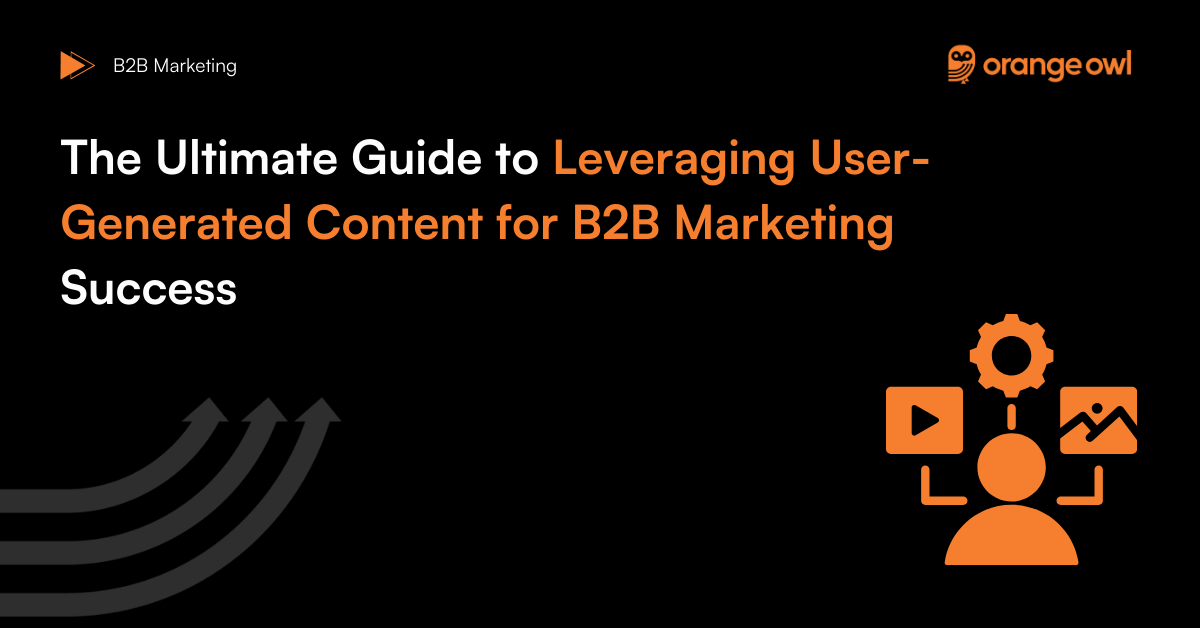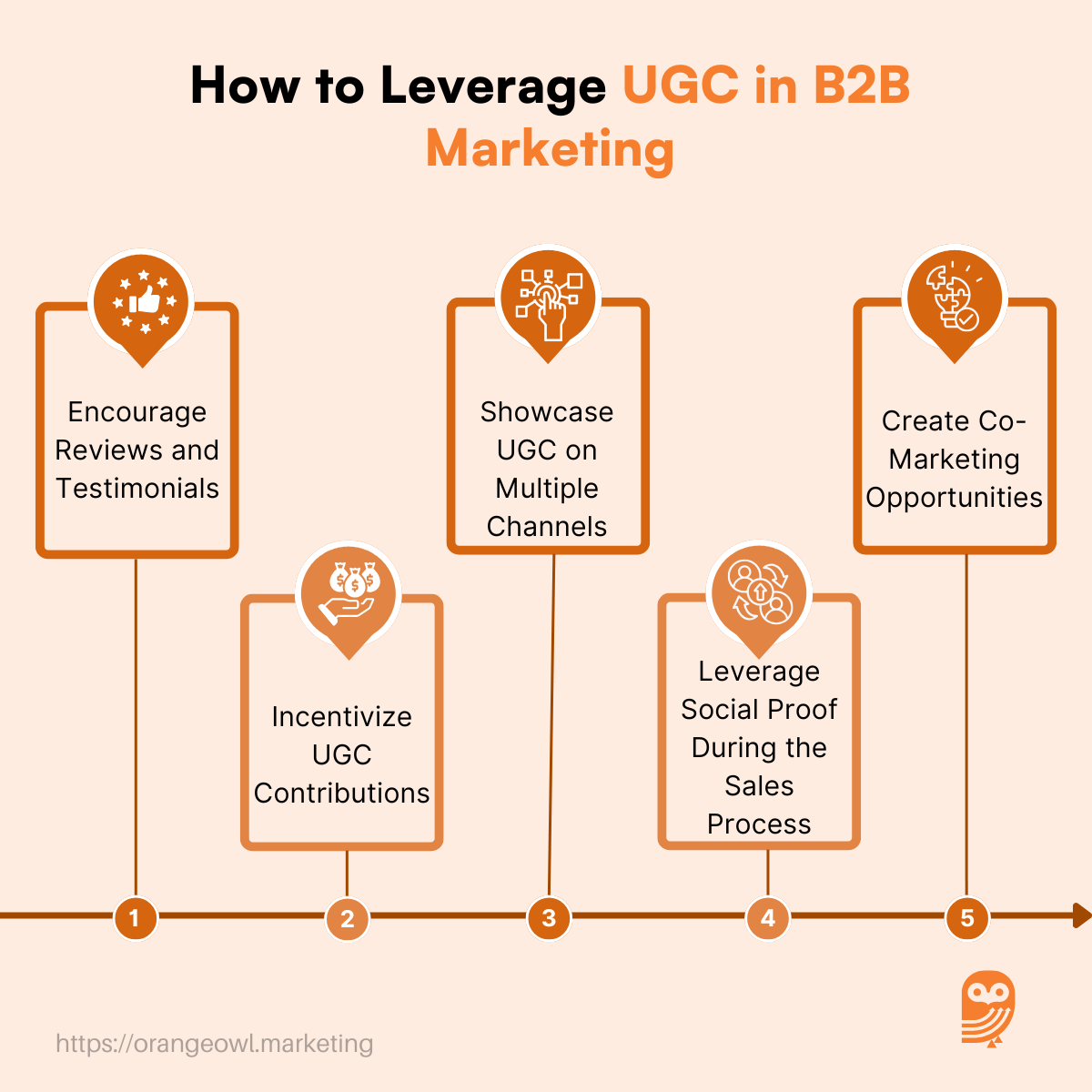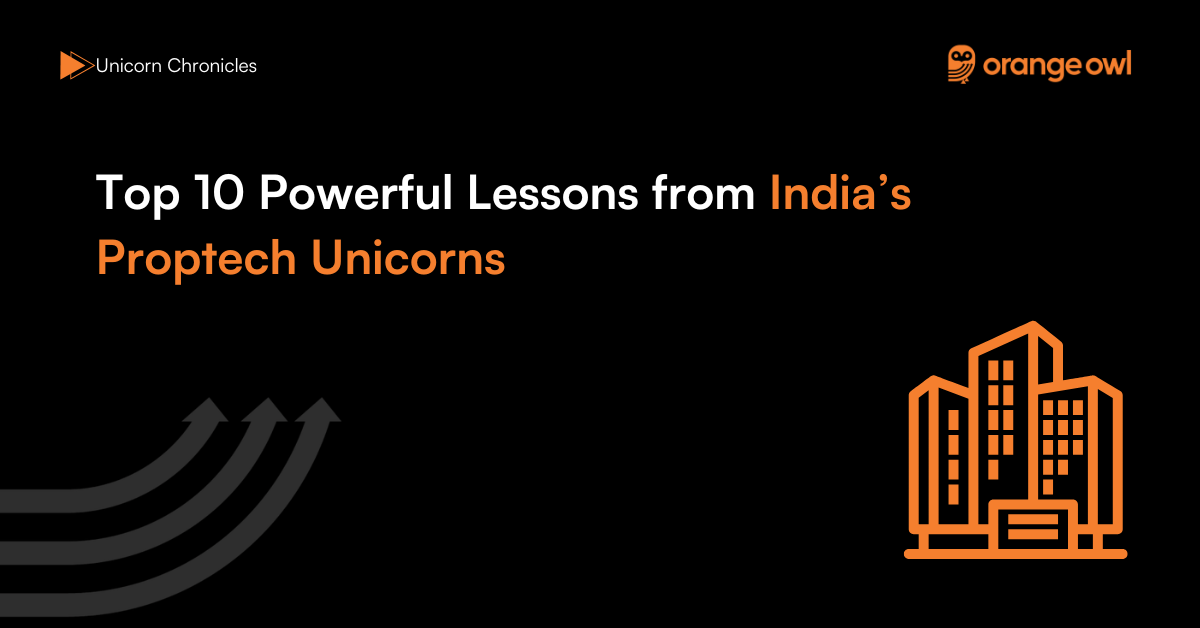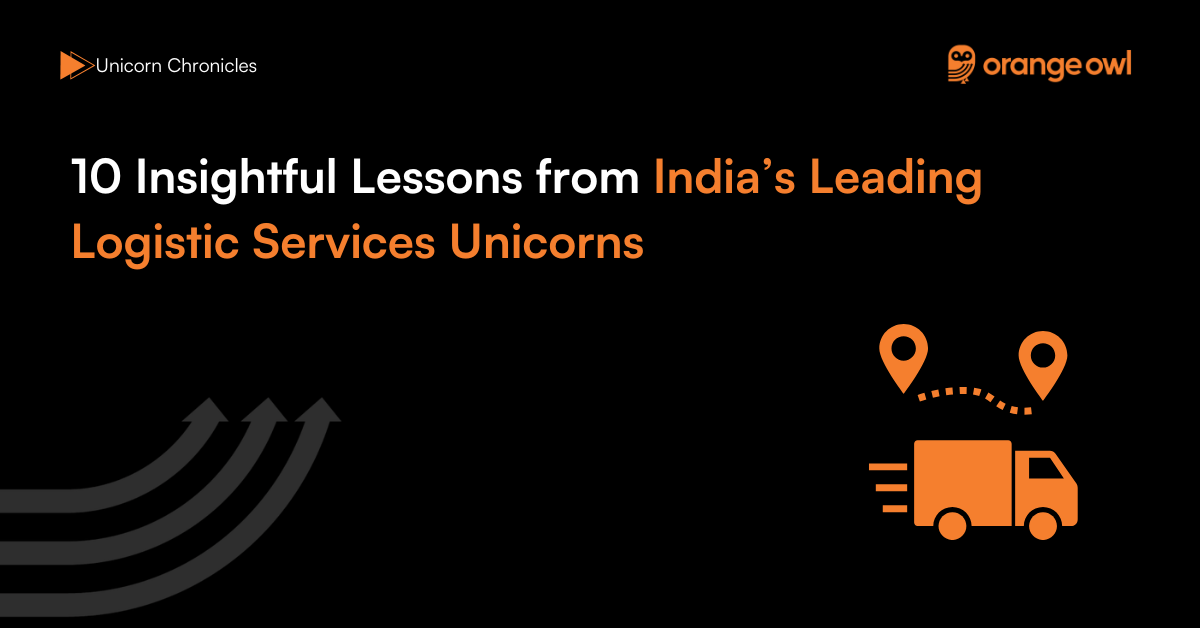The Ultimate Guide to Leveraging User-Generated Content for B2B Marketing Success
Orange Owl
February 13, 2025

Table of Contents
Introduction
In the dynamic realm of B2B marketing, decision-making is far more intricate than in B2C. Business buyers need assurance—proof that a product or service will deliver on its promises, align with their goals, and provide measurable value. Traditional marketing tools like whitepapers, case studies, and webinars have long been trusted for building credibility. However, there’s a rising star in the B2B space that brings an unparalleled level of trust and authenticity: User-Generated Content (UGC).
Unlike traditional content created by brands, UGC is developed directly by customers, clients, or partners. It includes testimonials, reviews, social media posts, or even co-created content such as webinars and blogs. In B2B marketing, where relationships and trust are critical, UGC acts as a powerful peer endorsement, helping prospective buyers see your value through the lens of real-world success stories. Nearly half (44%) of B2B buyers agree with the statement that “peer reviews and user-generated content are playing a greater role in the purchasing decision-making process.”
As buyers increasingly seek authenticity over polished ads, UGC is proving to be the bridge between skeptical decision-makers and businesses. But how exactly can B2B brands harness its potential to drive results? Let’s explore in this guide leveraging User-Generated Content for B2B Marketing success.
What is User-Generated Content?
User-Generated Content (UGC) is any content created by your customers or partners instead of your in-house marketing team. Examples in B2B marketing include:
- Client-authored blogs or reviews.
- Testimonials shared on your website or social media.
- Case studies created in collaboration with satisfied customers.
- Social media posts showcasing your product in action.
The beauty of UGC lies in its authenticity. Unlike branded content, it resonates more with prospects as it reflects genuine experiences and real results.
Why Should You Use User-Generated Content for B2B Marketing?
User-generated content (UGC) has become a cornerstone of successful marketing strategies, especially in the B2B space. Here’s why it’s a powerful tool for your business:
1. Enhances Trust
- Why it matters: Buyers inherently trust the opinions and experiences of their peers more than marketing messages from brands. In fact, 92% of consumers trust UGC more than traditional advertisements.
- How it works: UGC, such as testimonials, product reviews, or social media posts, provides authentic and relatable insights into your offerings. This builds confidence in prospective buyers, especially in B2B markets where the decision-making process often involves multiple stakeholders.
- Example: A LinkedIn post from a client describing how your product streamlined their operations resonates far more than a typical ad campaign.
2. Improves Conversion Rates
- Why it matters: UGC helps bridge the gap between awareness and decision-making by addressing common buyer hesitations. Prospective clients often look for proof of success before committing to a purchase.
- How it works: Content like detailed case studies or video testimonials from satisfied customers reduces uncertainty and provides social proof, leading to quicker decision-making.
- Example: A B2B SaaS company featuring a video testimonial on their landing page can experience a significant boost in sign-ups, as potential customers see evidence of real-world success.
3. Increases Engagement
- Why it matters: Relatable and authentic content encourages more interactions, fostering a sense of community among your audience. UGC is naturally more engaging than traditional branded content because it comes from real users.
- How it works: Sharing user-generated posts, such as social media shout-outs or video content, encourages likes, comments, and shares, amplifying your brand’s reach and visibility.
- Example: A client tagging your company on LinkedIn with a photo of your product in action can spark discussions and draw attention from other prospects in the same industry.
4. Cost-Effective Content
- Why it matters: Content creation is one of the most resource-intensive aspects of marketing. UGC solves this problem by leveraging the creativity and experiences of your customers.
- How it works: Instead of investing heavily in in-house content creation, you can curate and share content created by your customers, saving both time and money.
- Example: A webinar co-hosted with a satisfied client not only provides valuable insights but also eliminates the need for additional production costs for that particular content piece.
5. Drives Loyalty
- Why it matters: Customers who contribute UGC feel a deeper connection to your brand, as they become an integral part of your marketing efforts. This sense of recognition fosters long-term loyalty.
- How it works: By showcasing customer stories, reviews, or experiences, you make clients feel valued, increasing their likelihood of staying with your brand. Loyal customers also tend to create more UGC, creating a positive feedback loop.
- Example: Highlighting a client’s success story in your newsletter or social media post reinforces their relationship with your brand and inspires others to engage.
What’s the Difference Between User-Generated Content and Influencer Marketing?
Although they share some similarities, UGC and influencer marketing differ significantly:
- User-Generated Content:
- Organic and authentic content created by real users.
- Often free or incentivized minimally.
- Perfect for building credibility and trust.
- Influencer Marketing:
- Content created by individuals with large industry-specific followings.
- Paid partnerships aimed at amplifying brand reach.
- Primarily focuses on increasing visibility rather than showcasing real-world results.
UGC resonates more in B2B, as it comes directly from satisfied clients who have experienced the benefits of your solutions.
How to Leverage User-Generated Content in B2B Marketing
Harnessing User-Generated Content (UGC) in B2B marketing requires a strategic approach to ensure it aligns with your overall goals. Here’s how to effectively leverage UGC in your B2B marketing efforts:
1. Encourage Reviews and Testimonials
- Request Feedback Proactively: After completing a successful project, request feedback or testimonials from clients. Make it simple for them by providing clear instructions or templates they can follow.
- Use Review Platforms: Encourage clients to leave reviews on industry-specific platforms like G2, Trustpilot, or Clutch, where potential buyers actively seek insights.
- Create Video Testimonials: Video testimonials often have a higher impact as they add a personal and emotional element to your marketing.
2. Showcase UGC on Multiple Channels
- Website: Dedicate sections on your website to case studies, testimonials, and client stories. These elements are perfect for the “trust-building” phase of your sales funnel.
- Social Media: Share UGC on LinkedIn, Instagram, and Twitter to increase visibility and engagement. Use hashtags to make the content more discoverable.
- Email Marketing: Include client-generated content in your email campaigns to make them more relatable and persuasive.
3. Create Co-Marketing Opportunities
- Collaborative Webinars: Partner with clients to host webinars that highlight how your product or service helped them achieve success.
- Guest Blogging: Invite satisfied clients to share their stories or expertise through guest blogs on your website.
- Joint Case Studies: Co-create detailed case studies that outline the challenges, solutions, and results achieved through your collaboration.
4. Incentivize UGC Contributions
- Offer Recognition: Publicly recognize clients who contribute UGC by featuring them on your social media channels or in newsletters.
- Provide Exclusive Benefits: Offer small incentives like discounts, free tools, or early access to premium features for clients who create valuable content for you.
- Run Campaigns: Organize campaigns where customers can share their success stories for a chance to be featured in your marketing material.
5. Leverage Social Proof During the Sales Process
- Share Relevant Case Studies: Provide industry-specific UGC to potential buyers during the sales process. This helps them see how your product works for similar businesses.
- Add Reviews in Proposals: Highlight glowing reviews or testimonials directly in sales proposals to boost credibility.
- Use Metrics: Back UGC with measurable data. For instance, share a client’s testimonial that includes specific KPIs like increased efficiency or ROI improvements.

Types of User-Generated Content
UGC in B2B marketing comes in various forms, each serving a unique purpose. Here’s a detailed breakdown:
1. Testimonials
- What it is: Short, positive reviews from clients sharing their experience with your product or service.
- Why it’s effective: Testimonials are quick to read and establish instant credibility. Prospects trust the words of satisfied clients over promotional material.
- Example: A SaaS company showcasing a client’s review: “Using [Product Name], we reduced our reporting time by 50%, allowing us to focus more on strategic planning.”
2. Case Studies
- What it is: In-depth accounts of how your product or service solved a specific problem for a client.
- Why it’s effective: Case studies provide detailed insights into the challenges, solutions, and measurable outcomes, making them perfect for prospects in the consideration phase.
- Example: A logistics company creating a case study on how their solution reduced shipping costs for a major e-commerce client by 30%.
3. Social Media Posts
- What it is: Photos, videos, or written posts shared by clients showcasing your product in use.
- Why it’s effective: Social proof is powerful, and seeing real clients interact with your product builds trust and relatability.
- Example: A client sharing a LinkedIn post about how your collaboration boosted their business operations.
4. Collaborative Blogs and Webinars
- What it is: Content co-created with your clients, such as blogs, webinars, or podcasts.
- Why it’s effective: Collaboration showcases a strong partnership and allows clients to share their unique insights, which builds mutual credibility.
- Example: A co-hosted webinar on industry trends where your client shares how your product helps them stay competitive.
5. Product Reviews
- What it is: Honest assessments of your offerings on review platforms like Capterra, G2, or Trustpilot.
- Why it’s effective: Third-party reviews are highly trusted as they reflect genuine customer experiences.
- Example: A client rating your software 4.8/5 on G2 and mentioning specific features they found helpful.
Sources of UGC Content
Finding the right sources for UGC requires a proactive approach. Here’s a detailed look at where and how you can gather authentic UGC:
1. Client Advocacy Programs
- What it is: A structured program where your long-term clients are invited to share their success stories or participate in co-marketing opportunities.
- Why it works: Loyal customers are often enthusiastic about sharing their experiences and can create impactful content.
- Example: A software company inviting top clients to join an exclusive advocacy group that contributes testimonials and case studies.
2. Social Media Listening
- What it is: Monitoring social media platforms for mentions, hashtags, and posts related to your brand.
- Why it works: Clients often share their experiences unprompted, giving you genuine and relatable content.
- Example: A LinkedIn post by a customer tagging your company and praising your service for solving a critical issue.
3. Customer Surveys
- What it is: Surveys that ask for feedback on your product or service.
- Why it works: Surveys help collect specific insights that can be turned into quotes, testimonials, or even detailed case studies.
- Example: A survey response like, “Your tool helped us achieve a 20% increase in efficiency,” can become a powerful testimonial.
4. Events and Conferences
- What it is: Industry events where you interact with clients and prospects.
- Why it works: Live interactions often lead to spontaneous testimonials or discussions that can be repurposed into UGC.
- Example: Recording a client’s feedback during an event panel discussion.
5. Online Review Platforms
- What it is: Third-party platforms where customers leave reviews.
- Why it works: These platforms are highly trusted by prospects in the B2B space.
- Example: Reviews left on Capterra or Trustpilot highlighting specific features or outcomes achieved with your product.
Brands Using UGC in a Stand-Out Way
Some brands have mastered the art of leveraging UGC in innovative and impactful ways. Let’s look at how these companies set an example:
1. HubSpot
What they do: HubSpot prominently displays client testimonials, case studies, and success stories on its website and YouTube.
- Why it works: By showcasing diverse client experiences, HubSpot builds trust with potential customers across industries.
- Example: A video series called “Customer Stories” featuring businesses that scaled operations using HubSpot’s tools.
2. Salesforce
- What they do: Salesforce uses UGC in the form of client case studies and industry-focused webinars.
- Why it works: These resources provide in-depth insights into how Salesforce helps clients tackle industry challenges.
- Example: A case study on how a healthcare company improved patient data management using Salesforce’s CRM tools.
3. Slack
- What they do: Slack highlights client testimonials on their website and uses social media to showcase how businesses are using their platform for collaboration.
- Why it works: Slack’s focus on user stories creates a relatable narrative for potential customers.
- Example: Sharing LinkedIn posts from clients discussing how Slack improved team communication during remote work.
4. Zoom
- What they do: Zoom shares short-form testimonials and videos on LinkedIn and other platforms. They also showcase use cases in different industries.
- Why it works: By tailoring UGC to specific sectors, Zoom appeals to a wide range of potential clients.
- Example: A testimonial from a university sharing how Zoom transformed their online learning experiences.
5. Asana
- What they do: Asana features UGC in the form of client spotlights and success stories, particularly on their blog and social media platforms.
- Why it works: Asana’s focus on real-world applications of their software makes their value proposition clear.
- Example: A blog post about how a digital agency streamlined project management using Asana’s tools.
Conclusion
In a world where 90% of B2B buyers start their journey online and rely on peer reviews, the importance of User-Generated Content cannot be overstated. UGC provides an authentic, relatable perspective that helps cut through the noise of conventional marketing. By showcasing the voices of your satisfied clients and partners, UGC builds credibility, humanizes your brand, and fosters trust—key components of a successful B2B marketing strategy.
Integrating UGC into your marketing mix doesn’t just benefit your brand—it also strengthens relationships with existing customers, who feel valued and recognized for their contributions. Whether it’s a testimonial shared on LinkedIn, a customer co-authoring a blog, or a glowing review on G2, each piece of UGC serves as a digital word-of-mouth tool that accelerates your sales cycle and cements your reputation as an industry leader.
As B2B buyers demand more transparency and authenticity, now is the time to embrace UGC. Start small by encouraging reviews or testimonials, and gradually build a culture where your customers become your biggest advocates. In doing so, you’ll not only attract new business but also foster loyalty and long-term partnerships. UGC isn’t just content—it’s a strategic asset that drives trust, engagement, and growth in the competitive B2B marketplace.
Frequently Asked Questions(FAQs) on User-Generated Content for B2B Marketing
Traditional B2B marketing content is created by a company’s marketing team and includes whitepapers, case studies, eBooks, and blog posts. These materials are crafted to align with brand messaging and strategic goals.
UGC, on the other hand, is created by customers, partners, or industry professionals who use or interact with your product or service. It includes testimonials, social media posts, user-submitted reviews, co-created blogs, and video content. Unlike traditional content, UGC offers a layer of authenticity and peer endorsement that can be more persuasive than brand-generated content.
The B2B sales cycle is often lengthy due to multiple decision-makers and high-value deals. UGC can accelerate the process by providing social proof and reducing skepticism.
- Builds Immediate Trust – Reviews and testimonials from existing customers reassure prospects about your product’s credibility.
- Addresses Common Pain Points – Case studies and user-shared experiences highlight real-world problem-solving capabilities.
- Eliminates Objections – When buyers see their industry peers vouching for a product, they are more likely to move forward in the sales funnel.
For example, a SaaS company featuring customer-generated case studies on its website can help potential buyers see direct results, reducing the time spent on deliberation.
B2B businesses can showcase UGC across multiple channels to maximize its impact:
- Company Website – A dedicated section for case studies, testimonials, and success stories.
- LinkedIn – The most effective social media platform for B2B, where user reviews and client shout-outs can generate engagement.
- Review Sites – Platforms like G2, Capterra, and Trustpilot help potential buyers see unbiased feedback.
- Webinars & Podcasts – Featuring customers as speakers can serve as a compelling endorsement.
- Email Marketing – Sharing customer-generated stories in newsletters adds authenticity to outreach efforts.
Unlike B2C, where customers voluntarily share experiences, B2B companies need a proactive strategy to encourage UGC:
- Request Testimonials – After a successful project, ask clients to share their feedback.
- Host Contests or Campaigns – Incentivize clients to post about your product with exclusive offers or features.
- Offer Recognition – Showcase customers’ stories on social media or company blogs, giving them industry visibility.
- Make It Easy – Provide simple templates or prompts to guide clients in writing reviews.
B2B UGC comes in different formats, each serving a unique purpose:
- Case Studies – In-depth analyses of how your product/service helped a client solve a specific problem.
- Testimonials – Short, impactful quotes from satisfied customers.
- Video Reviews – Client-recorded video testimonials enhance credibility and engagement.
- LinkedIn Recommendations – Professional endorsements that carry significant weight.
- Co-Created Blogs/Webinars – Featuring client insights adds industry expertise and credibility.
UGC plays a critical role in attracting and converting leads by:
- Enhancing SEO – User reviews and testimonials increase content variety and search rankings.
- Improving Social Proof – Prospects trust recommendations from peers more than branded ads.
- Boosting Engagement – Customer-driven discussions create organic reach and brand visibility.
For example, a cybersecurity company that features customer success stories on LinkedIn may attract more inbound leads from companies with similar challenges.
While UGC is highly effective, it comes with challenges:
- Getting Clients to Participate – B2B clients may be hesitant to publicly endorse vendors due to corporate policies.
- Maintaining Brand Consistency – User-generated content varies in tone and quality, requiring careful curation.
- Handling Negative Feedback – Critical reviews need to be managed professionally to maintain credibility.
To overcome these challenges, businesses can offer incentives, provide content guidelines, and actively engage with both positive and negative feedback.
Yes! UGC is a versatile asset that can be repurposed across various marketing efforts:
- Blog Content – Turn customer testimonials into in-depth case studies.
- Social Media Snippets – Convert positive reviews into visually engaging posts.
- Sales Presentations – Include UGC in sales decks to provide real-world validation.
- Webinars & Email Campaigns – Feature user insights to strengthen engagement.
Using UGC requires careful handling to avoid legal and ethical issues:
- Obtain Permission – Always get explicit consent before publishing customer-generated content.
- Follow Platform Policies – Adhere to guidelines on review sites and social media platforms.
- Disclose Partnerships – If UGC is incentivized, disclose the nature of the relationship to maintain transparency.
- HubSpot – Features customer success stories prominently on its website and social media.
- Salesforce – Uses video testimonials and case studies from clients to showcase impact.
- Adobe – Encourages businesses to share creative work using its software, building strong community engagement.
These examples illustrate how B2B brands effectively use UGC to build credibility, drive engagement, and accelerate conversions.


